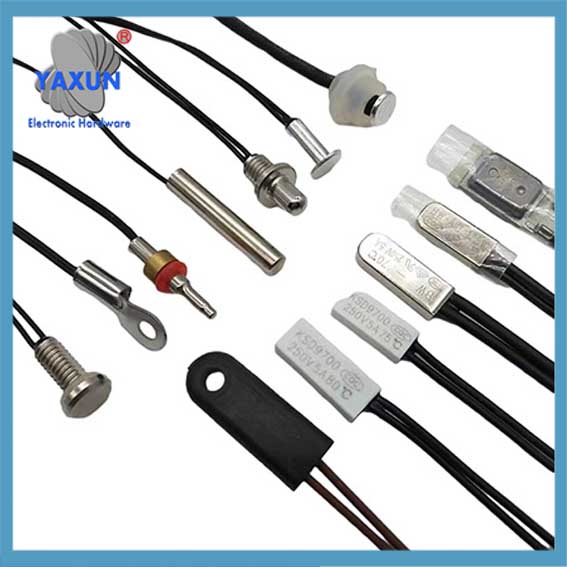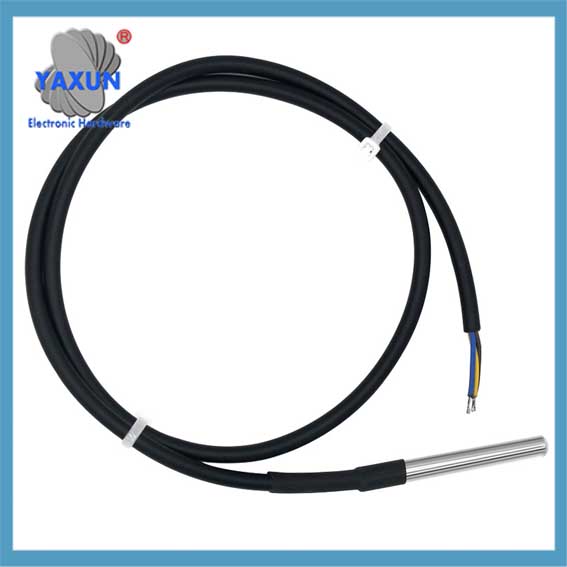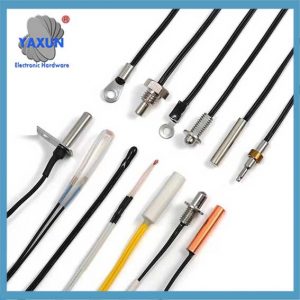產品類別
產品標籤
溫度探頭, 溫度感測器類型 & 應用
溫度探頭是一種用來測量溫度的裝置, 通常由敏感元件和測量電路組成. 敏感元件可以是熱電偶 (100分, 1000 分), 熱電阻 (NTC, 正溫度係數), 半導體 (DS18B20數字), ETC。, 它可以將溫度變化轉換成電訊號. 然後就被放大了, 過濾的, 轉換的, 並由測量電路處理, 最後輸出與溫度成正比的電訊號.
溫度探頭和溫度感測器是兩種不同的設備, 它們在測量溫度方面都有各自的特點和應用場景.
溫度探頭
A “溫度探頭” 是一種透過將熱能轉換為可測量的電訊號來測量溫度的感測器, 探頭內最常見的溫度感測器類型包括熱電偶, 電阻溫度探測器 (RTD), 和熱敏電阻, 根據所需的精度,每種都有獨特的特性和應用, 溫度範圍, 以及特定情況所需的回應時間.
定義: 溫度探頭是一種用來測量溫度的裝置, 通常由敏感元件和測量電路組成. 敏感元件可以是熱電偶 (100分, 1000 分), 熱電阻 (NTC, 正溫度係數), 半導體 (DS18B20數字), ETC。, 它可以將溫度變化轉換成電訊號. 然後就被放大了, 過濾的, 轉換的, 並由測量電路處理, 最後輸出與溫度成正比的電訊號.
工作原理: 溫度探頭的工作原理是利用敏感元件對溫度變化的反應,將溫度變化轉換成電訊號. 常見的敏感元件包括熱電偶, 熱電阻, 半導體, ETC. 熱電偶的工作原理是利用兩種不同金屬或合金的熱電效應. 當它們在不同溫度下連接在一起時, 產生與溫度成比例的電動勢. 熱電阻的工作原理是利用金屬或半導體材料的電阻隨溫度變化的特性. 當溫度變化時, 電阻值也會隨之變化. 半導體的工作原理是利用半導體材料的電導率隨溫度變化的性質. 當溫度變化時, 電導率也會隨之改變.
類型: 溫度探頭的種類主要有熱電偶探頭, 熱電阻探頭, 半導體探針, ETC. 熱電偶探頭使用熱電偶作為敏感元件, 並具有測量範圍寬的特點, 反應速度快, 和高精度. 熱電阻探頭採用熱電阻作為敏感元件, 並具有測量精度高的特點, 穩定性好, 且抗干擾能力強. 半導體探針採用半導體作為敏感元件, 且具有體積小的特點, 輕的, 和低功耗.
應用領域: 溫度探頭廣泛應用於工業領域, 科學研究, 醫療保健, 環保等領域. 如化工中的溫度測量與控制, 石油, 冶金, 電, 製藥, 食品及其他行業.
帶探頭的 DS18B20 溫度感測器電纜
接線: 紅色的(電壓控制電路), 黃色的(數據), 黑色的(接地)
寬溫度範圍 -55 ℃~ +125 ℃
電源: 3.0電壓~5.5V
尖端: 在數據和VCC之間使用4.7K電阻將使探頭的測試更容易.
熱電偶:
功能: 根據兩根不同金屬線交界處的溫度產生電壓差.
優點: 溫度範圍寬 (-200°C 至 1750°C), 相對便宜, 快速反應時間.
缺點: 與其他感測器相比精度較低, 需要校準表將電壓轉換為溫度.
應用領域: 熔爐等高溫應用, 引擎監控, 工業製程.
熱敏電阻:
溫度探頭的應用:
工業流程: 監控烤箱等製造過程中的溫度, 反應爐, 和擠出機.
暖通空調系統: 透過監測氣溫來調節建築物的室溫.
食品安全: 監控食品烹調和儲存過程中的溫度,確保食品安全.
醫療器材: 透過插入患者體內的探頭測量患者體溫.
汽車產業: 監測引擎冷卻液溫度和駕駛室溫度.
科學研究: 實驗中精確的溫度測量.
溫度感應器
定義: 溫度感測器是一種能將溫度變化轉換成電訊號的裝置. 通常由敏感元件和訊號處理電路組成. 敏感元件可以是熱電偶, 熱電阻, 半導體, ETC. 訊號處理電路可以是類比電路, 數位電路, ETC。, 共同完成收購, 溫度訊號的處理和輸出.
工作原理: 溫度感測器的工作原理與溫度探頭類似. 它還利用敏感元件對溫度變化的反應,將溫度變化轉換成電訊號. 然而, 溫度感測器通常具有較複雜的訊號處理電路, 可以對溫度訊號進行更高階的處理, 例如數位轉換, 資料儲存, 溝通, ETC.
類型: 溫度感測器的種類主要有類比溫度感測器, 數位溫度感測器, 和智慧溫度感測器. 類比溫度感測器輸出類比訊號, 需要透過類比數位轉換器將其轉換為數位訊號. 數位溫度感測器直接輸出數位訊號, 並具有抗干擾能力強的特點, 高精準度, 且易於集成. 智慧溫度感測器具有自我診斷等功能, 自校準, 和溝通, 並可實現遠端監控與控制.
特徵: 溫度感測器具有測量精度高的特點, 穩定性好, 抗干擾能力強, 且易於集成. 不同類型的溫度感測器有不同的特性, 例如類比溫度感測器需要類比數位轉換器, 數位溫度感測器直接輸出數位訊號, 智慧溫度感測器具有自我診斷等功能, 自校準, 和溝通.
應用領域: 溫度感測器廣泛應用於智慧家居, 智慧穿戴, 醫療設備, 工業自動化, 環境監測等領域, 例如空調, 冰箱, 洗衣機, 溫度計, 血壓計, 工業控制系統, ETC.
如何選擇?
選擇溫度探頭或溫度感測器時, 需要考慮以下因素:
應用環境: 考慮被測環境是否有腐蝕性等特殊條件, 高溫, 高壓, ETC。, 從而選擇合適的材質和防護等級.
測量範圍: 根據被測溫度範圍選擇合適的感測器,確保感測器在要求的範圍內準確測量.
精度要求: 根據溫度測量應用的精度要求選擇相應精度的感測器.
成本預算: 根據預算限制選擇高性價比感測器.
如何使用?
使用溫度探頭或溫度感測器時, 需要注意以下事項:
安裝: 依照感測器安裝說明正確安裝,確保感測器與被測物體良好接觸,避免因安裝不當造成測量誤差.
接線: 正確連接感測器的訊號線和電源線,確保訊號傳輸的穩定性和準確性.
校準: 定期校準感測器,確保其測量精度符合應用要求.
維護: 定期清潔和維護感測器,避免灰塵, 污垢, ETC. 影響感測器的測量性能.
溫度探頭感測器是我們YXAUN公司的重要產品之一. 我們專注於智慧製造和工業自動化領域, 並提供一系列高精度、穩定的測控設備, 包括溫度探頭感測器. 我們的溫度探頭感測器廣泛應用於工業製造, 環境監測, 能源管理等產業高精度, 穩定性和複雜環境適應性. 如果您對我們的溫度探頭感測器有特定需求或疑問, 請隨時諮詢我們. 我們將竭誠為您提供專業的解答和服務. 您想了解溫度探頭感測器的哪些方面?
如何選擇合適的溫度探頭感測器?
選擇溫度探頭感測器時, 考慮溫度測量範圍, 精度要求, 響應速度和安裝環境. 例如, 工業環境可選擇熱電偶或鉑電阻, PT100 高精度, 和熱電偶以實現快速響應.
聯絡我們
等待您的電子郵件, 我們將在短時間內回覆您 12 小時提供您所需的有價值的信息.
 English
English Afrikaans
Afrikaans العربية
العربية বাংলা
বাংলা bosanski jezik
bosanski jezik Български
Български Català
Català 粤语
粤语 中文(简体)
中文(简体) 中文(漢字)
中文(漢字) Hrvatski
Hrvatski Čeština
Čeština Nederlands
Nederlands Eesti keel
Eesti keel Suomi
Suomi Français
Français Deutsch
Deutsch Ελληνικά
Ελληνικά हिन्दी; हिंदी
हिन्दी; हिंदी Magyar
Magyar Bahasa Indonesia
Bahasa Indonesia Italiano
Italiano 日本語
日本語 한국어
한국어 Latviešu valoda
Latviešu valoda Lietuvių kalba
Lietuvių kalba македонски јазик
македонски јазик Bahasa Melayu
Bahasa Melayu Norsk
Norsk پارسی
پارسی Polski
Polski Português
Português Română
Română Русский
Русский Cрпски језик
Cрпски језик Slovenčina
Slovenčina Slovenščina
Slovenščina Español
Español Svenska
Svenska ภาษาไทย
ภาษาไทย Türkçe
Türkçe Українська
Українська اردو
اردو Tiếng Việt
Tiếng Việt












